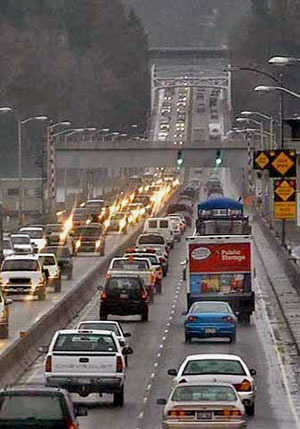3/3/96
This is the html version of the file http://www.leg.wa.gov/pub/billinfo/1995-96/Pdf/Bill%20Reports/House%20Historical/2551%20BRH%20TR.pdf.
G o o g l e automatically generates html versions of documents as we crawl the web.
To link to or bookmark this page, use the following url: http://www.google.com/search?q=cache:5nXMJ587KboJ:www.leg.wa.gov/pub/billinfo/1995-96/Pdf/Bill%2520Reports/House%2520Historical/2551%2520BRH%2520TR.pdf+seatac+taxis+regulation+limos&hl=en&ct=clnk&cd=2&gl=us&client=firefox-a
Google is neither affiliated with the authors of this page nor responsible for its content.
These search terms have been highlighted: seatac regulation
These terms only appear in links pointing to this page: taxis limos
Page 1
HOUSE BILL REPORT
HB 2551
As Reported By House Committee On:
Transportation
Title: An act relating to the regulation of limousines and for hire vehicles carrying
passengers.
Brief Description: Regulating limousines.
Sponsors: Representatives Cairnes, Patterson, Ogden, Romero, Tokuda, Mitchell, Quall
and K. Schmidt.
Brief History:
Committee Activity:
Transportation: 1/18/96 [DP].
HOUSE COMMITTEE ON TRANSPORTATION
Majority Report: Do pass. Signed by 25 members: Representatives K. Schmidt,
Chairman; Benton, Vice Chairman; Mitchell, Vice Chairman; R. Fisher, Ranking
Minority Member; Hatfield, Assistant Ranking Minority Member; Backlund; Blanton;
Brown; Buck; Cairnes; Chandler; Chopp; Elliot; Hankins; Johnson; McMahan;
Ogden; Patterson; Quall; Robertson; Romero; D. Schmidt; Scott; Sterk and Tokuda.
Staff: Mary McLaughlin (786-7309).
Background: In 1989 the Utilities and Transportation Commission (UTC) was given
exclusive regulatory authority over limousines. The commission is charged with
safety, equipment, and insurance requirements. Entry into the field is unlimited if the
applicant can prove financial responsibility; no rate or route regulation may be
imposed. Because of the broad statutory definition of limousines and the lack of
enforcement by the UTC due to severe cutbacks in the agency, there is concern over
the public safety of the passengers, the qualifications of the drivers, the conditions of
the vehicles, and the types of vehicles being used as limousines.
Cities, counties, and port districts may regulate taxicab companies operating within
their jurisdictions, and may control entry, rate, route, licensing, and safety. Both
King County and the city of Seattle have chosen to regulate taxicabs and have
imposed a moratorium on the number of taxicabs that may operate within their
jurisdictions in order to stabilize the market. The city and county have developed
HB 2551
-1-
House Bill Report
Page 2
stringent guidelines to enforce licensing, rates, routes, driver qualifications, safety and
vehicle inspection provisions. Because limousines may be operated in King County in
a more relaxed regulatory environment than taxicabs, there has been a dramatic rise
in the number of limousines in the city, county, and at SeaTac International Airport.
At the end of 1989 there were 94 limousine permits issued for use at SeaTac Airport;
by 1995 the number had risen to 410 permits. At SeaTac this increase in limousine
traffic has resulted in frequent solicitation of passengers within the terminal and
inconsistency in the type of vehicles used. There is evidence that some vehicles lack
the proper insurance and operating authority required by the UTC.
Summary of Bill: The regulation of limousines is transferred from the Utilities and
Transportation Commission (UTC) to the Department of Licensing (DOL). The
department regulates entry, equipment, chauffeur qualifications, and operations. In
addition, the Port of Seattle may regulate limousines with regard to entry, chauffeur
qualifications, operations, and equipment at SeaTac International Airport. No rate
regulation may be imposed, but the carrier must file its rates and schedules with the
port. King County may adopt ordinances to assist the port in enforcement at SeaTac
Airport; this does not grant King County the authority to regulate limousines within
its jurisdiction.
A new definition of limousine service is created, which divides the vehicles into four
categories. A limousine is a for-hire, chauffeur-driven, unmetered, unmarked luxury
motor vehicle that meets one of the following definitions:
(1)
"stretch limousine" is an automobile whose wheelbase has been altered, has
a seating capacity of no more than 12 passengers, and is equipped with
amenities;
(2)
"executive sedan" is a four-door sedan with a minimum wheelbase of
114.5 inches, a seating capacity of no more than three passengers behind
the driver, and standard factory amenities;
(3)
"executive van" is a van, minivan, or minibus with a seating capacity of
seven to 14 passengers behind the driver; or
(4)
"classic" is a fine and distinctive automobile that is 30 years old or older.
A limousine carrier must have an office; a vehicle cannot solely be used as an office.
Arrangements for service are prearranged through the carrier’s office and dispatched
to the limo. Customers cannot make arrangements with the driver for immediate
rental of a limousine, even if the driver is the owner. The single exception is stand-
hail limousines at SeaTac Airport that are licensed by the port.
The Washington State Patrol (WSP) annually inspects each limousine licensed by
DOL, except if the Port of Seattle chooses to regulate limousines within its
HB 2551
-2-
House Bill Report
Page 3
jurisdiction; in that case, it is the port or King County (rather than the WSP) that is
responsible for the annual inspection.
A limousine carrier must certify that each chauffeur (1) is 21 years of age, (2) holds a
valid Washington driver’s license, (3) has successfully completed a training course
and written exam approved by DOL, (4) has passed a background check performed by
the WSP, and (5) submits a medical certificate upon initial application and every three
years thereafter validating the driver’s fitness.
DOL may refuse, suspend, or revoke a license of a limousine carrier if it has good
reason to believe that the carrier hired a chauffeur that (1) has been convicted of an
offense that makes the driver unfit to qualify as a chauffeur, (2) has been found guilty
of two or more offenses resulting in revocation of the driver’s license, (3) has been
convicted of vehicular homicide or assault, or (4) is intemperate or addicted to
narcotics.
Limousine carriers must list their unified business identifier when advertising and
specify the type of service offered (stretch limo, executive sedan or van, or classic
auto). A limousine carrier cannot advertise as a taxicab company.
A vehicle operated as a limousine before April 1, 1996, is grandfathered into the new
regulatory process if the owner is the same as the registered owner on April 1, 1996,
and the vehicle and carrier otherwise comply with the new limousine statutes.
Unlawful operation of a limousine without a certificate is a misdemeanor on first
offense and a gross misdemeanor thereafter. Violation of the insurance provisions
and false advertising are gross misdemeanors.
Cities, counties, and port districts may regulate for-hire vehicles within their
respective jurisdictions with regard to entry, rates, routes, safety, and licensing.
(This is in addition to DOL’s current licensing and insurance regulations.)
Appropriation: None.
Fiscal Note: Not requested.
Effective Date: Ninety days after adjournment of session in which bill is passed.
Testimony For: The new regulations governing limousines will level the playing
field between the taxicab and limousine industries, and will promote the safety of the
drivers, vehicles, and passengers.
Testimony Against: None.
HB 2551
-3-
House Bill Report
Page 4
Testified: Representative Jack Cairnes, prime sponsor; Mike Zawaideh, Limousine
Association of Washington; Robert Long, Limousine Association of Washington; Mel
McDonald, city of Seattle; Richard Irvin, Limousine Association of Washington;
Peter Bailey, Evergreen Towncar Service; Jayelyn Thresher, Limousine Association
of Washington; Carmen Bullard, representing towncar operators; Doug Bohlke,
Evergreen State Taxi Association; Ed Stemkoski, Farwest Taxi; Jack Blunk, North
End Taxi; Tom Tanaka, Port of Seattle; Vazgen Abramyan, United Towncars; Jim
Fricke, Pacific Northwest Transportation Services; and John Ruhl, Seattle-Tacoma
International Taxi Association.
HB 2551
-4-
House Bill Report
The phrase,'Unsound Transit', was coined by the Wall Street Journal to describe Seattle where,"Light Rail Madness eats billions that could otherwise be devoted to truly efficient transportation technologies." The Puget Sound's traffic congestion is a growing cancer on the region's prosperity. This website, captures news and expert opinion about ways to address the crisis. This is not a blog, but a knowledge base, which collects the best articles and presents them in a searchable format. My goal is to arm residents with knowledge so they can champion fact-based, rather than emotional, solutions.
Transportation
Monday, March 10, 2008
HB 2251 addresses Limousine Rules
Labels:
0.723 HB 2551 Limos,
6.25 Limo Rules
The articles are posted solely for educational purposes to raise awareness of transportation issues. I claim no authorship, nor do I profit from this website. Where known, all original authors and/or source publisher have been noted in the post. As this is a knowledge base, rather than a blog, I have reproduced the articles in full to allow for complete reader understanding and allow for comprehensive text searching...see custom google search engine at the top of the page. If you have concerns about the inclusion of a specific article, please email bbdc1@live.com. for a speedy resolution.









